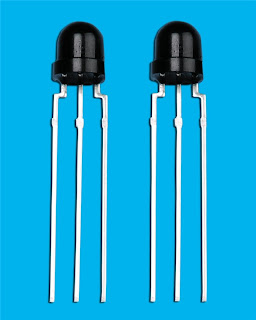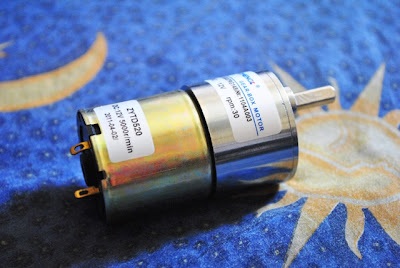Etching Process
Wednesday, February 22, 2012
Wednesday, February 15, 2012
Week 5
PIC Fan controller
This project it´s based on a
PIC16F877A, with the purpose of control a FAN
with PWM (Pulse with Modulation). It offers a
variable speed control, low acoustic noise,
reliability, long lifetime, low power
consumption, protection features. The MCU get
the temperature from the sensor (D18B20), and
after will do a conversion Celsius degrees and
then it´s generated a PWM on PORTC.2 with 6
different levels.
|
PWM
|
TEMPERATURE
|
|
15%
|
<= 49°
|
|
30%
|
50° |
|
40%
|
51° |
|
50%
|
52° |
|
75%
|
53° |
|
100%
|
>54° |
After the signal goes to
Q1 (BC338) in order to control the duty cycle in
the fan. I had to use two transistors to have an
Ic on Q2 to be enough to activate the fan.
Because the MCU only generate a maxim of 3.6V on
which output, and 15% of 3.6V is 0.5V to
polarize Q1 we need 0.7V.
How to calculate
the Q1 and Q2:

You will be
able to control the FAN between 5V and
+/-12V.The BC338 have a current load of
800mA that is value of a fan can have, you
can use two or more fans as long the current
load isn´t more than 800mA. The output of
MCU connect to the Q1 and Q2 it works like a
switch, the D3 it´s for protection from the
magnetic field in the inductors from the
FAN, without the D3 when you turn off the
system the current will be discharge to the
Q2 and could damage it.
|
Connectors
|
|
|
J1 |
Expansions PORTS |
|
Source |
12V |
|
Sensor |
D18B20 |
|
FAN |
Connect the FAN |
|
ICSP |
To program with PICKIT2 |
Pictures:
Link
Thursday, February 9, 2012
Week 4
IR Receiver
 |
| IR Receiver |
This is a simple IR receiver circuit which plugs into a serial port of a computer. There are many other circuits of this kind, and most of them are even simpler, but this circuit has two major advantages:
(1) it uses an Atmel AVR RISC microcontroller (an AT90S2313) instead of the usual PIC microcontroller
(2) it uses a Maxim MAX232 for the generation of valid RS232 levels.
Advantage 1: is, of course, only valid for all those AVR addicts which have this device (and the corresponding programmer) ready at hand and don't care about PICs and PIC programmers.
Advantage 2: comes into play if the IR receiver has to placed at a great distance from the computer. The MAX232 is more likely to deliver valid signals over bigger distances than cheaper solutions.
The IR receiver can receive it's +5V supply voltage from the keyboard or mouse connector of the computer (either from an unused PS/2 port or via a pass-thru adapter). If the IR interface is placed at a great distance from the computer, I power it with an external stabilized 5V DC power supply instead of the PS/2 port.
The interface communicates at 19200 baud, unidirectional (that means, it only transmits data and does not care anything about data which the computer send), without flow control. For every level transition in the demodulated IR signal, it transmits a single byte which corresponds to the time since the previous transition, capping off at a value of 255. It works reliable with a Sony remote control (using the special Sony protocol), and I have also successfully tested it with an Onkyo remote control (I think this one uses the standard RC5 protocol, but I'm not sure). Decoding happens on the computer; I use PC Remote Control for this.
Appendix:
 |
| Infrared Receiver |
 |
| Infrared Receiver to RF Transmitter Circuit |
 |
| IR receiver sensor |
Link link2 link3 link4
Thursday, February 2, 2012
Week 3
Electric Gearbox Motor 12v
Motors need to be isolated from the AVR. This is because they
produce a high voltage spike when the current flow through them suddenly
changes. This can damage the digital circuitry in the microcontroller.
To separate the Gear-Box Motor from the microcontroller we used 4N35
optoisolators. Furthermore, ULN2003 drivers are used to supply the
motor's high current needs since the microcontroller has a maximum
current rating of 40mA. The drivers contain diodes to protect the
circuitry from high voltage spikes by directing the current through the
power supply.
The motor is controlled using an 8-step sequence to halve the rated
step angle. The step sequence rate is controlled via software. The 8
step sequence not only slows down the motor but also allows more
accurate positioning of the platform.
Specifications:
1) Diameter :37mm shaft: 6mm
2) 12v Custom made speed, Torque etc
 |
| Assembling DC motor:(diameterxlength=35.8x57.0mm) |
 |
| Geared motor installation: |
Appendix:
 |
| 1 |
 |
| 2 |
 |
| 3 |
 |
| 4 |
 |
| 5 |
Subscribe to:
Posts (Atom)


















